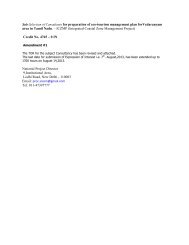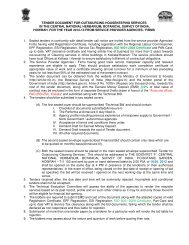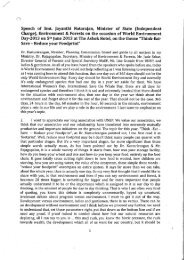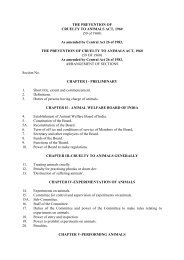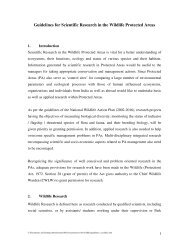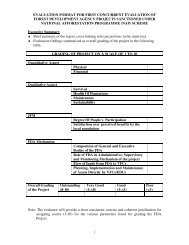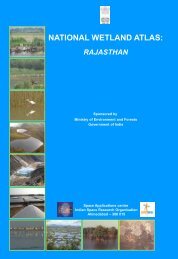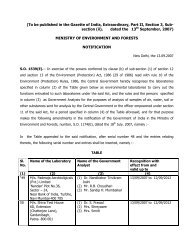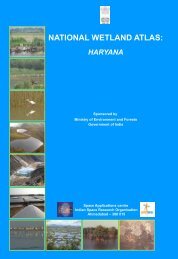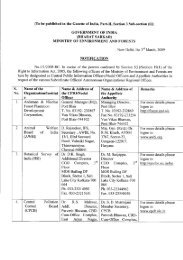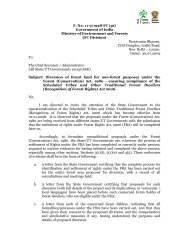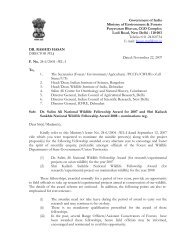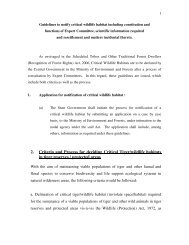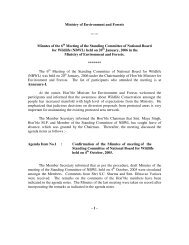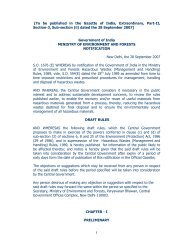Bt Cotton Hybrids Evaluation Report â Central Zone (2006-07 ...
Bt Cotton Hybrids Evaluation Report â Central Zone (2006-07 ...
Bt Cotton Hybrids Evaluation Report â Central Zone (2006-07 ...
You also want an ePaper? Increase the reach of your titles
YUMPU automatically turns print PDFs into web optimized ePapers that Google loves.
i<br />
<br />
<strong>Bt</strong> <strong>Cotton</strong> <strong>Hybrids</strong> <strong>Evaluation</strong> <strong>Report</strong> – <strong>Central</strong> <strong>Zone</strong> (<strong>2006</strong>-<strong>07</strong>)<br />
EXECUTIVE SUMMARY<br />
The All India Coordinated <strong>Cotton</strong> Improvement Project of Indian Council of<br />
Agricultural Research was assigned the task of evaluating <strong>Bt</strong> <strong>Cotton</strong> <strong>Hybrids</strong> in <strong>Central</strong><br />
<strong>Zone</strong> during <strong>2006</strong>-<strong>07</strong>. In the first year intra-hirsutum hybrids trial, 23 <strong>Bt</strong> cotton hybrids<br />
were evaluated along with three checks. Hybrid RCH 2 <strong>Bt</strong> was the common <strong>Bt</strong> check and<br />
NHH 44 was the common Non <strong>Bt</strong> check. The first year trials were conducted at 14<br />
locations under both irrigated (5) and rainfed conditions (9) and the trials were laid out in<br />
both protected and unprotected conditions. The locations were <strong>Cotton</strong> Research Station,<br />
Khandwa, Main <strong>Cotton</strong> Research Station, Surat, <strong>Cotton</strong> Research Station, Junagadh,<br />
<strong>Cotton</strong> Research Station, Talod and Agricultural Research Station, Borwat Farm,<br />
Banswara under irrigated condition. The rainfed trials were conducted at Dr.PDKV,<br />
Akola, Agricultural Research Station, Achalpur, <strong>Cotton</strong> Research Station, Nanded,<br />
<strong>Cotton</strong> Research Station, Parbhani, <strong>Central</strong> Institute for <strong>Cotton</strong> Research, Nagpur, <strong>Cotton</strong><br />
Research Station, Bharuch, Dry Farming Research Station, Rajkot, College of<br />
Agriculture, Indore, and Regional Research Station, Bhawanipatna.<br />
In the first year interspecific (hirsutum x barbadense) hybrids trial, three <strong>Bt</strong><br />
hybrids of viz., NCHB 945 <strong>Bt</strong> (Nuziveedu seeds), Kasinath <strong>Bt</strong> (Nath seeds) and<br />
Paraslaxmi <strong>Bt</strong> (Emergent Genetics) were evaluated along with MRC 6918 <strong>Bt</strong> (<strong>Bt</strong> check)<br />
and DCH 32 (non <strong>Bt</strong> check). The trial locations were College of Agriculture, Indore and<br />
Agricultural Research Station, Banswara.<br />
Nine <strong>Bt</strong> <strong>Cotton</strong> hybrids were evaluated for the second year in succession for<br />
confirmatory results. The trials were conducted under both irrigated conditions<br />
(at <strong>Cotton</strong> Research Station, Khandwa and at <strong>Cotton</strong> Research Station, Surat) and under<br />
rainfed conditions (Dr. PDKV, Akola, <strong>Cotton</strong> Research Station, Nanded and at <strong>Central</strong><br />
Institute for <strong>Cotton</strong> Research, Nagpur).<br />
<br />
!
ii<br />
<br />
<br />
<br />
Twenty three <strong>Bt</strong> cotton hybrids were evaluated under both protected and<br />
unprotected conditions. The trial data from five irrigated centers and eight rainfed<br />
centers were analysed to study the effectiveness of <strong>Bt</strong> gene in controlling the bollworms<br />
and adaptability of these genotypes to various agroclimatic situations in <strong>Central</strong> <strong>Zone</strong>.<br />
The incidence of Earias spp. and H. armigera was very low. Pink bollworm<br />
incidence was less in several centers, but at Khandwa and Banswara the damage was<br />
considerable. The damage on some of the <strong>Bt</strong> test hybrids was on par with that on non-<strong>Bt</strong><br />
hybrids. Similarly, square damage at Banswara, Bharuch and Khandwa was more as<br />
compared to other centers. Overall, the mean larval population and square damage on <strong>Bt</strong><br />
cotton hybrids was less as compared to non-<strong>Bt</strong> check hybrids. Open boll and locule<br />
damage on <strong>Bt</strong> test hybrids were found to be on par with that of the <strong>Bt</strong> check hybrid but<br />
much lower than that seen in non-<strong>Bt</strong> check hybrid.<br />
Jassid was the main sucking pest, apart from Aphids and Thrips at certain<br />
locations. Most of the hybrids evaluated showed varying degrees of susceptibility to<br />
sucking pests warranting chemical intervention more than once. <strong>Bt</strong> hybrids required less<br />
than one round of chemical intervention to control the bollworms.<br />
The test <strong>Bt</strong> hybrids have been found susceptible to the four foliar diseases viz.,<br />
alternaria leaf spot, grey mildew, myrothecium leaf spot and bacterial leaf blight. With<br />
timely and proper interventions, these diseases can be managed.<br />
As regards mean seed cotton yield, seven <strong>Bt</strong> test hybrids viz., Ankur Akka BG II,<br />
IT 923 <strong>Bt</strong>, Sudershan <strong>Bt</strong>, Rudra <strong>Bt</strong>, VICH 15 <strong>Bt</strong>, Dhruv <strong>Bt</strong> and Ankur Jai <strong>Bt</strong> were found<br />
to be superior to the check hybrids under both irrigated and rainfed situations. Under<br />
unprotected conditions also, they were found to be superior to the check hybrids.<br />
Nine <strong>Bt</strong> test hybrids were found to be superior to the check hybrids under rainfed<br />
conditions only. They are: Tulasi 4 BG II, NCS 929 <strong>Bt</strong>, Sigma <strong>Bt</strong>, Atal BG II, Tulasi 9<br />
<br />
!
iii<br />
<strong>Bt</strong>, BCHH 557 BG II, Nandi 405 <strong>Bt</strong>, JKCH 666 <strong>Bt</strong> and PCH 923 <strong>Bt</strong>. These hybrids<br />
established their yield superiority, both under protected and unprotected conditions.<br />
Fibre quality-wise, all the entries were found to be superior to NHH 44 (non-<strong>Bt</strong><br />
check) and were on par with the <strong>Bt</strong> check hybrid. The highest fibre length was recorded<br />
by IT 923 <strong>Bt</strong>.<br />
<br />
<br />
Among the three inter specific hybrids evaluated, bollworm and square damage<br />
was the lowest in hybrid Kasinath <strong>Bt</strong>. It also recorded the lowest jassid incidence. With<br />
a mean seed cotton yield of 878 kg/ha, Kasinath <strong>Bt</strong> was superior to the best check MRC<br />
6918 by 54 per cent. Quality wise it was on par with DCH 32, the non <strong>Bt</strong> check.<br />
<br />
<br />
<br />
<br />
Nine <strong>Bt</strong> cotton hybrids were evaluated at four locations. Boll worm damage in<br />
terms of larval population, square damage, open boll and locule damage was minimum<br />
during the year. Even under low infestation levels, the non <strong>Bt</strong> hybrid NHH 44 recorded<br />
considerable damage. The <strong>Bt</strong> test hybrids recorded very low levels of damage and was on<br />
par with the <strong>Bt</strong> check hybrids (Table 82).<br />
Even though the test <strong>Bt</strong> hybrids have shown susceptibility to the foliar diseases<br />
prevalent in the particular area, through proper management techniques, damage to the<br />
crop can be averted.<br />
In seed cotton yield, seven <strong>Bt</strong> test hybrids were superior to the check hybrids. Of<br />
these four hybrids viz., RCH 386 <strong>Bt</strong>, MRC 7351 BG II, JKCH 99 <strong>Bt</strong> and ACH 155-2<br />
BG II were superior under both protected and unprotected conditions. <strong>Hybrids</strong> KD CHH<br />
621 BG II, MRC 7341 BG II and KDCHH 9810 <strong>Bt</strong> were superior under protected<br />
conditions only.<br />
<br />
!
iv<br />
<strong>Hybrids</strong> RCH 386 <strong>Bt</strong> and MRC 7351 BG II were superior in fibre length. Hybrid<br />
KDCHH 621 BG II recorded the lowest fibre strength. Micronaire showed variation<br />
across locations and RCH 138 <strong>Bt</strong> (Check) had the lowest Micronaire.<br />
<br />
Nine <strong>Bt</strong> cotton hybrids were evaluated for two successive years during 2005-06<br />
and <strong>2006</strong>-<strong>07</strong> in <strong>Central</strong> <strong>Zone</strong>. The hybrids were evaluated at five locations in Khandwa,<br />
Surat, Akola, Nanded and Nagpur. The crop at Surat during the second year was affected<br />
due to floods and was not taken for analysis.<br />
Jassids, Thrips and Aphids were the main sucking pests. All the <strong>Bt</strong> hybrids<br />
evaluated were susceptible to sucking pests at varying intensities and grades. Chemical<br />
intervention was required to control them. The <strong>Bt</strong> hybrids showed minimum damage to<br />
bollworm with reduced green boll and locule damage.<br />
The onset and severity of the foliar disease varied both years. The <strong>Bt</strong> hybrids<br />
have been found susceptible to these diseases. However, proper and timely plant<br />
protection measures can reduce the damage to the crop.<br />
In terms of mean seed cotton yield, under protected conditions, only two hybrids<br />
viz., RCH 386 <strong>Bt</strong> and JKCH 99 BT were found to be superior to the check hybrids.<br />
However, under unprotected conditions, apart from RCH 386 <strong>Bt</strong>, MRC 7351 BG II and<br />
ACH 155-2 BG II were also superior to the check hybrids. Fibre quality wise the <strong>Bt</strong> test<br />
hybrids were superior to the non <strong>Bt</strong> check hybrid NHH 44 and were on par with the <strong>Bt</strong><br />
check hybrids.<br />
***<br />
<br />
!



